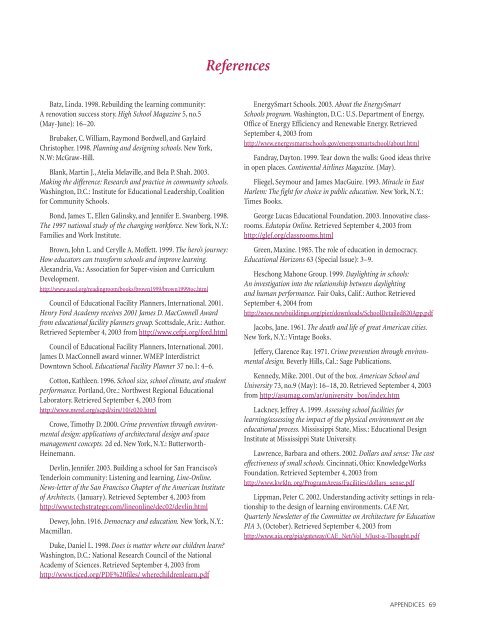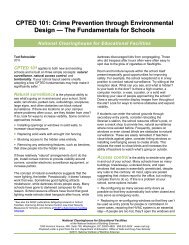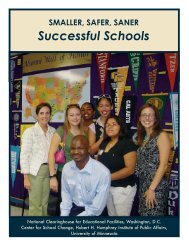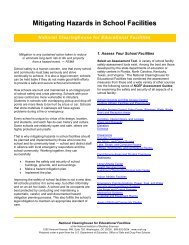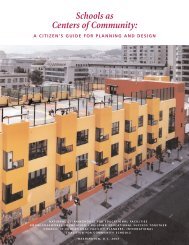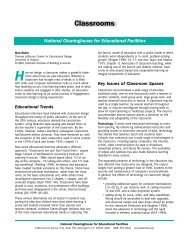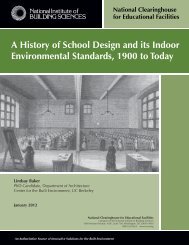References - National Clearinghouse for Educational Facilities
References - National Clearinghouse for Educational Facilities
References - National Clearinghouse for Educational Facilities
You also want an ePaper? Increase the reach of your titles
YUMPU automatically turns print PDFs into web optimized ePapers that Google loves.
<strong>References</strong><br />
Batz, Linda. 1998. Rebuilding the learning community:<br />
A renovation success story. High School Magazine 5, no.5<br />
(May-June): 16–20.<br />
Brubaker, C. William,Raymond Bordwell, and Gaylaird<br />
Christopher. 1998. Planning and designing schools. New York,<br />
N.W: McGraw-Hill.<br />
Blank, Martin J., Atelia Melaville, and Bela P. Shah. 2003.<br />
Making the difference: Research and practice in community schools.<br />
Washington, D.C.: Institute <strong>for</strong> <strong>Educational</strong> Leadership, Coalition<br />
<strong>for</strong> Community Schools.<br />
Bond, James T., Ellen Galinsky, and Jennifer E. Swanberg. 1998.<br />
The 1997 national study of the changing work<strong>for</strong>ce. New York, N.Y.:<br />
Families and Work Institute.<br />
Brown, John L. and Cerylle A. Moffett. 1999. The hero’s journey:<br />
How educators can trans<strong>for</strong>m schools and improve learning.<br />
Alexandria, Va.: Association <strong>for</strong> Super-vision and Curriculum<br />
Development.<br />
http://www.ascd.org/readingroom/books/brown1999/brown1999toc.html<br />
Council of <strong>Educational</strong> Facility Planners, International. 2001.<br />
Henry Ford Academy receives 2001 James D. MacConnell Award<br />
from educational facility planners group. Scottsdale, Ariz.: Author.<br />
Retrieved September 4, 2003 from http://www.cefpi.org/<strong>for</strong>d.html<br />
Council of <strong>Educational</strong> Facility Planners, International. 2001.<br />
James D. MacConnell award winner. WMEP Interdistrict<br />
Downtown School. <strong>Educational</strong> Facility Planner 37 no.1: 4–6.<br />
Cotton, Kathleen. 1996. School size, school climate, and student<br />
per<strong>for</strong>mance. Portland, Ore.: Northwest Regional <strong>Educational</strong><br />
Laboratory. Retrieved September 4, 2003 from<br />
http://www.nwrel.org/scpd/sirs/10/c020.html<br />
Crowe, Timothy D. 2000. Crime prevention through environmental<br />
design: applications of architectural design and space<br />
management concepts. 2d ed. New York, N.Y.: Butterworth-<br />
Heinemann.<br />
Devlin, Jennifer. 2003. Building a school <strong>for</strong> San Francisco’s<br />
Tenderloin community: Listening and learning. Line-Online.<br />
News-letter of the San Francisco Chapter of the American Institute<br />
of Architects. (January). Retrieved September 4, 2003 from<br />
http://www.techstrategy.com/lineonline/dec02/devlin.html<br />
Dewey, John. 1916. Democracy and education. New York, N.Y.:<br />
Macmillan.<br />
Duke, Daniel L. 1998. Does is matter where our children learn<br />
Washington, D.C.: <strong>National</strong> Research Council of the <strong>National</strong><br />
Academy of Sciences. Retrieved September 4, 2003 from<br />
http://www.tjced.org/PDF%20files/ wherechildrenlearn.pdf<br />
EnergySmart Schools. 2003. About the EnergySmart<br />
Schools program. Washington, D.C.: U.S. Department of Energy,<br />
Office of Energy Efficiency and Renewable Energy. Retrieved<br />
September 4, 2003 from<br />
http://www.energysmartschools.gov/energysmartschool/about.html<br />
Fandray, Dayton. 1999. Tear down the walls: Good ideas thrive<br />
in open places. Continental Airlines Magazine. (May).<br />
Fliegel, Seymour and James MacGuire. 1993. Miracle in East<br />
Harlem: The fight <strong>for</strong> choice in public education. New York, N.Y.:<br />
Times Books.<br />
George Lucas <strong>Educational</strong> Foundation. 2003. Innovative classrooms.<br />
Edutopia Online. Retrieved September 4, 2003 from<br />
http://glef.org/classrooms.html<br />
Green, Maxine. 1985. The role of education in democracy.<br />
<strong>Educational</strong> Horizons 63 (Special Issue): 3–9.<br />
Heschong Mahone Group. 1999. Daylighting in schools:<br />
An investigation into the relationship between daylighting<br />
and human per<strong>for</strong>mance. Fair Oaks, Calif.: Author. Retrieved<br />
September 4, 2004 from<br />
http://www.newbuildings.org/pier/downloads/SchoolDetailed820App.pdf<br />
Jacobs,Jane. 1961. The death and life of great American cities.<br />
New York, N.Y.: Vintage Books.<br />
Jeffery, Clarence Ray. 1971. Crime prevention through environmental<br />
design. Beverly Hills, Cal.: Sage Publications.<br />
Kennedy, Mike. 2001. Out of the box. American School and<br />
University 73, no.9 (May): 16–18, 20. Retrieved September 4, 2003<br />
from http://asumag.com/ar/university_box/index.htm<br />
Lackney, Jeffrey A. 1999. Assessing school facilities <strong>for</strong><br />
learning/assessing the impact of the physical environment on the<br />
educational process. Mississippi State, Miss.: <strong>Educational</strong> Design<br />
Institute at Mississippi State University.<br />
Lawrence, Barbara and others. 2002. Dollars and sense: The cost<br />
effectiveness of small schools. Cincinnati,Ohio: KnowledgeWorks<br />
Foundation. Retrieved September 4, 2003 from<br />
http://www.kwfdn. org/ProgramAreas/<strong>Facilities</strong>/dollars_sense.pdf<br />
Lippman, Peter C. 2002. Understanding activity settings in relationship<br />
to the design of learning environments. CAE Net,<br />
Quarterly Newsletter of the Committee on Architecture <strong>for</strong> Education<br />
PIA 3, (October). Retrieved September 4, 2003 from<br />
http://www.aia.org/pia/gateway/CAE_Net/Vol_3/Just-a-Thought.pdf<br />
APPENDICES 69
<strong>National</strong> Center <strong>for</strong> Education Statistics. 2000. Condition of<br />
America’s public school facilities: 1999. Washington, D.C.: U.S.<br />
Department of Education. Retrieved September 4, 2003 from<br />
http://nces.ed.gov/pubs2000/2000032.pdf<br />
<strong>National</strong> Center <strong>for</strong> Education Statistics. 1999. How old are<br />
America’s public schools Washington, D.C.: U.S. Department of<br />
Education. Retrieved September 4, 2003 from<br />
http://nces.ed.gov/surveys/FRSS/publications/1999048/<br />
<strong>National</strong> Center <strong>for</strong> Education Statistics. 2002. Overview of elementary<br />
and secondary schools and districts, school year 2000–01.<br />
Washington, D.C.: U.S. Department of Education.<br />
<strong>National</strong> Center <strong>for</strong> Education Statistics. 2002. Projections of<br />
education statistics to 2012. Washington, D.C.: U.S. Department of<br />
Education. Retrieved September 4, 2003 from<br />
http://nces.ed.gov/pubs2002/2002030.pdf<br />
<strong>National</strong> Education Association. 2000. Modernizing our schools:<br />
What will it cost Washington, D.C.: Author. Retrieved September 4,<br />
2003 from http://www.nea.org/ lac/modern/modrpt.pdf<br />
Newman, Oscar. 1972. Defensible space: crime prevention<br />
through urban design. New York, N.Y.: MacMillan.<br />
Price Charities. 2003. <strong>Educational</strong> programs. San Diego, Cal.:<br />
Author. Retrieved September 4, 2003 from<br />
http://www.pricecharities. com/objectives<br />
Quinn, Jane. 2003. Community school fact sheet. P.S. 5, the Ellen<br />
Lurie School. New York, N.Y.: Children’s Aid Society. Retrieved<br />
September 4, 2003 from<br />
http://www.childrensaidsociety.org/media/general/cas-PS_5.pdf<br />
Schneider, Mark. 2002. Do school facilities affect academic<br />
outcomes Washington, D.C.: <strong>National</strong> <strong>Clearinghouse</strong> <strong>for</strong><br />
Educa-tional <strong>Facilities</strong>. Retrieved September 4, 2003 from<br />
http://www.edfacilities.org/pubs/outcomes.pdf<br />
Schneider, Tod, Hill Walker, and Jeffery Sprague. 2000. Safe<br />
school design, a handbook <strong>for</strong> educational leaders: applying the<br />
principles of crime prevention through environmental design.<br />
Eugene, Ore.: ERIC <strong>Clearinghouse</strong> <strong>for</strong> <strong>Educational</strong> Management.<br />
Stevenson, Kenneth R. 2002. Ten educational trends shaping<br />
school planning and design. Washington, D.C.: <strong>National</strong><br />
<strong>Clearinghouse</strong> <strong>for</strong> <strong>Educational</strong> <strong>Facilities</strong>. Retrieved September 4,<br />
2003 from http://www.edfacilities.org/pubs/trends.pdf<br />
Sullivan, Kevin J. 2002. Catching the age wave: Building schools<br />
with senior citizens in mind. Washington, D.C.: <strong>National</strong><br />
<strong>Clearinghouse</strong> <strong>for</strong> <strong>Educational</strong> <strong>Facilities</strong>. Retrieved September 4,<br />
2003 from http://www.edfacilities.org/pubs/agewave.pdf<br />
Sustainable Buildings Industry Council. 2001. High per<strong>for</strong>mance<br />
school buildings resource and strategy guide. Washington, D.C.:<br />
Author.<br />
21st Century School Fund. 2002. Building outside the box;<br />
public-private partnership: a strategy <strong>for</strong> improved public<br />
school buildings. Washington, D.C.: Author. Retrieved<br />
September 4, 2003 from<br />
http://www.21csf.org/csf-home/Documents/Oyster/Building_Outside_Box.pdf<br />
U.S. Department of Education, Office of Public Affairs. 2000.<br />
Growing pains: The challenge of overcrowded schools is here to stay.<br />
Washington, D.C.: Author. Retrieved September 4, 2003 from<br />
http://www.ed.gov/pubs/bbecho00/<br />
U.S. Department of Education and the Regional <strong>Educational</strong><br />
Laboratory Network. 1996. Putting the pieces together: Comprehensive<br />
school-linked strategies <strong>for</strong> children and families.<br />
Washington, D.C.: Author. Retrieved September 4, 2003 from<br />
http://www.ncrel.org/sdrs/areas/issues/envrnmnt/css/ppt/putting.htm<br />
Washor,Elliot. 2003. Personalized learning: Preparing high<br />
school students to create their futures. Providence, R.I.:<br />
The Metropolitan Career and Technical Center. Retrieved<br />
September 4, 2003 from<br />
http://www.bigpicture.org/PersonalizedLearningBook.htm<br />
Williams, Betty C. 1991. Brief history of Crow Island School<br />
excerpted from Still a special place: A history of Crow Island School,<br />
Winnetka, Illinois. Winnetka, Ill.: Author. Retrieved September 4,<br />
2003 from http://www.winnetka.k12.il.us/ci/ci_brief_history.htm<br />
Winnetka Public School District. 2003. Crow Island School:<br />
What’s in a name Winnetka, Ill.: Author. Retrieved<br />
September 4, 2003 from<br />
http://www.winnetka.k12.il.us/ci/ci_name.htm<br />
Additional In<strong>for</strong>mation<br />
See the NCEF resource lists Community Participation in School<br />
Planning, Community Use of School Buildings, <strong>Facilities</strong> Master<br />
Planning, and <strong>Educational</strong> <strong>Facilities</strong> Planning—Overview online at<br />
http://www.edfacilities.org/rl/<br />
<strong>National</strong> <strong>Clearinghouse</strong> <strong>for</strong> <strong>Educational</strong> <strong>Facilities</strong>, 1090<br />
Vermont Avenue, N.W., Suite 700, Washington, D.C. 20005-4905<br />
Phone: 202-289-7800 or 888-552-0624 Fax: 202-289-1092.<br />
E-mail: ncef@nibs.org Internet: www.edfacilities.org<br />
70 SCHOOLS AS CENTERS OF COMMUNITY: A CITIZEN’S GUIDE FOR PLANNING AND DESIGN
NATIONAL CLEARINGHOUSE FOR EDUCATIONAL FACILITIES<br />
KNOWLEDGEWORKS FOUNDATION • BUILDING EDUCATIONAL SUCCESS TOGETHER<br />
COUNCIL OF EDUCATIONAL FACILITY PLANNERS, INTERNATIONAL<br />
COALITION FOR COMMUNITY SCHOOLS


